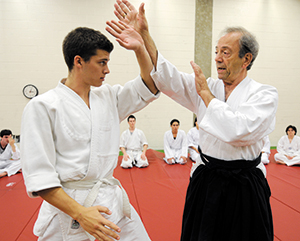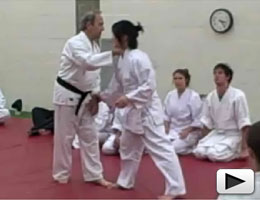Going to the mat
In Donald Levine’s Conflict Theory and Aikido class, the goal is not to learn to fight but rather to harmonize.
By Carrie Golus, AB’91, AM’93
Photography by Dan Dry
From the ankles up, the 24 students in Cobb 101 look like they’re enrolled in an ordinary lecture/discussion course. But at the request of teaching assistant Dan Kimmel, AB’06, AM’07, the students have removed their shoes. There are bare feet, dark socks, and white socks in shades of gray.
As Kimmel passes around handouts, Donald Levine, AB’50, AM’54, PhD’57, the Peter B. Ritzma professor of sociology, quietly removes his shoes, revealing his own dark socks. He bows, greets the class in Japanese, and then pads to the board, where he writes the greeting: Onegai shimasu—pronounced something like “oh-nee-gosh-ee-mas.” For the teacher, Levine explains, it means, “Please receive my instruction”; for students, “Please give me your instruction.”
 “You can call me whatever you want outside of class,” sociologist Don Levine says, “but on the mat, I’m sensei.”
“You can call me whatever you want outside of class,” sociologist Don Levine says, “but on the mat, I’m sensei.” It’s the first day of Conflict Theory and Aikido, an unlikely cross between sociology and physical education. On Mondays from 2:30 to 4:20, the class meets in Cobb. On Wednesdays and Fridays from 2:45 to 4:20, there are mat sessions at Henry Crown Field House. The two-pronged approach explores relationships between aikido and such areas as leadership training, psychotherapy and healing arts, youth work, mediation, and conflict resolution. An expert on Ethiopian politics and society and a scholar of liberal-education philosophy, Levine has used akido in his work on conflict resolution, the relationship between body and society, and “masculinity and warriorhood.”
“How many of you had heard of aikido by the time you went to college?” asks Levine. Most students raise their hands. “Twenty years ago,” says Levine—around the time he began teaching the course—“no one would have heard of it.”
He draws the three kanji characters that make up the word on the board. Ai (harmony) and ki (energy) are simple enough, but “I always have trouble with do,” Levine notes as he writes the complex symbol. Do means “the way,” he says, so “aikido, strictly translated, is ‘the way of harmonizing energies.’” The students scribble in notebooks; only one uses a laptop.
Suddenly Kimmel is on his feet, and he and Levine demonstrate an aikido move in the cramped space between the chairs and the board. Pressing their forearms against each other, the two are not fighting, Levine explains: “We’re harmonizing.”
Next he breaks the meaning of dojo into its parts: do (way) and jo (place). “It’s important that there are these special protected places where you learn in a really intense way. You could say the University is a dojo,” he says, “or a monastery, or your room.”
More terminology: students should refer to him as sensei. “You can call me whatever you want outside of class,” Levine says, “but on the mat, I’m sensei.” He chalks up two more terms: uke (the person who launches an attack) and nage (the one who responds).
An hour in, Levine calls a five-minute break. While waiting for him to return, Kimmel, a second-year graduate student in sociology, tells the class he would prefer not to be called sensei. Although he holds a third-degree black belt in tae kwon do, he is relatively new to aikido, so he prefers sempai (senior student). “Or,” he says with comic timing, “you can call me Dan.”
The informal discussion turns to the different belt colors in various martial arts. A dark-haired male student asks, in accented English, what would happen if you decided to wear a black belt without earning it.
Kimmel is aghast. “It would just be extremely disrespectful and embarrassing,” he says. “It would be like calling yourself a professor and walking in and starting to teach a class.” Despite—or perhaps because of—Kimmel’s disapproval, the student seems impishly taken by the idea. “Anyone could have a black belt,” Kimmel says. “They cost about three dollars.” The student laughs, appearing to contemplate the idea.
Henry Crown’s multipurpose room is not so much a room as an enormous indoor field, carpeted in Astroturf. The mat session meets in one corner, partly closed off by a nylon curtain.
Five students—presumably with martial-arts backgrounds—wear white training uniforms (gis). One man wears a theatrically flowing, dark-blue garment (“It’s for kendo,” Kimmel explains. “That’s the one with the swords.”). The rest of the class, who’ll have a chance to order gis later this afternoon, wear sweats, yoga pants, or shorts and T-shirts.
Levine strolls in wearing a white gi,a black belt, and grey plastic sandals. He begins the class with a ritual: turning his back to the group, he bows, claps twice, bows again, then turns and bows toward the class, ending with, “Onegai shimasu!”
Levine teaches the students how to sit seiza: knees bent, feet tucked under. “Most Americans, and today most Japanese, are not used to sitting this way,” he says. If the position becomes too uncomfortable, he says, the proper course of action is to bow, then shift into a more comfortable pose.
Next come back rolls: students roll onto their backs, then up to sitting. After a few minutes, they’re adept at letting the momentum bring them up to their knees. Finally they learn to roll all the way up to standing. A slim man in a white T-shirt and black baggy sweats executes the seiza so easily it seems effortless. For his neighbor, thicker around the middle, it’s a struggle.
The point of the training is to learn to fall without hurting yourself, Levine explains, abruptly pushing Kimmel to the floor. The goal is to go “from fear of falling to love of flying,” he says. “The earth is your friend. It’s good to be close to the earth, just as it’s good to be reaching toward heaven.”
Having covered how to fall, Levine demonstrates how to stand and how to pivot. The students in gis are not necessarily leagues ahead of their peers; a guy with a long wavy ponytail consistently pivots the wrong way.
The pupils divide into pairs, then take turns pushing each other in the chest. “That’s why posture is so important,” Levine says, demonstrating how easy it is to push Kimmel over if he’s looking down. “Posture has all kinds of implications for how we are with ourselves, and how we are with the world.”
At 3:10 baseball players begin striding across the room. By 3:15, crash after crash echoes from beyond the screen: batting practice.
Now Levine shows what to do if grabbed by the wrist: spin backward and end up standing next to the attacker, shoulder-to-shoulder, in a move distinctly similar to the cha-cha. More practice.
“I have a couple honest enough to admit they’re having problems,” Levine announces to the group, as if the two had come in for therapy. The others sit down to watch as the attractive pair—an African American woman with short natural hair and a tall white man with an eyebrow ring he forgot to remove—fumble their way through. At one point, everyone agrees, the man ends up in a position that looks uncomfortable.
“Do you want the person who’s attacking you to feel angry and frustrated, or comfortable?” Levine asks. The counterintuitive answer, he says, is “comfortable—but knowing that he will not hurt you.”
The goal, Levine continues, is the opposite of the old sports adage, “Winning isn’t everything; it’s the only thing.” In aikido, “Winning isn’t everything, it’s nothing.” He pauses for effect; behind the nylon curtain, more baseballs crash. “Losing is nothing also.”
Return to topSyllabus
By Carrie Golus, AB’91, AM’93
Photography by Dan Dry
Levine’s catalog description for Conflict Theory and Aikido frames the course in questions: “What is conflict? What forms does it take? Is conflict good or bad?” Readings include The Functions of Social Conflict by Lewis Coser, Sword and Brush by David Lowry, Architectonics of Meaning by Walter Watson, Constructive Conflicts by Louis Kriesberg, The Spirit of Aikido by Kisshomaru Ueshiba, and The Conquest of Violence by Joan Bondurant; three reading packets (A, B, and C); and the Hyde Park Peace Dojo Handbook.
 Donald Levine
Donald Levine This year students are also expected to attend a November 14–15 conference on Aikido in Higher Education, organized by Levine, at which professors from around the world will discuss how they incorporate aikido into business, education, ethics, philosophy, rhetoric, and sociology courses.
Grades are based on outlines of the assigned readings (20 percent), class participation including a journal about the mat sessions (20 percent), mat session attendance (20 percent), mat test (15 percent), and a final paper partly based on the journal (25 percent). Asked if the final paper should be a reflection or an argument, Levine shrugs. “Either,” he says. “Argue with yourself.”
Return to topWRITE THE EDITOR
EMAIL THIS ARTICLE
SHARE THIS ARTICLE
MORE FROM THE MAGAZINE
WEB EXTRA
Watch Donald Levine’s mat session

